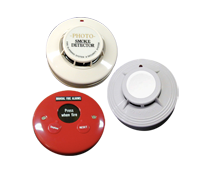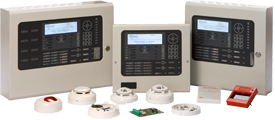Fire alarm does not refer to the latest inventions, its history dates back to long-ago 1907, its birthplace is Russia. One of the first fire alarm devices was a cargo suspended on an oiled rope. In the case of fire the rope burned up quickly and the cargo activated the bell. Since then such systems have passed a whole evolution. Developers and specialists-technologists are in constant search for the most effective modernization, complementing the systems with effective functionality that increases the level of fire safety.
The main purpose of the fire alarm is timely and constant control, prompt detection of fire, warning with a view to the most rapid firefighting. The whole system is a set of technical equipment that detects the place of ignition, timely transmits information to the fire station and activates the automatic fire extinguishing.
The main indicator of fire alarm is a sensor (detector), which is designed to respond to thermal, light or chemical effects.
 There are the following types of sensors:
There are the following types of sensors:
- Thermal sensors. They are actuated by thermal effect, in simple terms, they come into action when the permissible threshold temperature in the premise is exceeded. Thermal sensors are installed in those premises where it is impossible to install other types due to the specifics of the premise.
- Gas sensors. Such sensors come into action when the chemical composition of air in the promise changes. In the process of smoldering or burning the composition of air changes, certain chemical impurities are emitted into it. Such sensors are very sensitive and have proven their effectiveness.
- Smoke sensors. Such a sensor refers to the most common kind, the process of its operation is simple. But there are disadvantages of this element - it can accidentally react to dust or fumes.
- Light sensors. Reaction is made using counter-built-in photosensitive devices.
- Hybrid sensors. According to experts’ opinion, this is the most effective and operating type, most commonly, thermal and smoke sensors are combined.
- Threshold systems. When installing the threshold alarm, the detector has a certain threshold of action. Such fire alarms are cost-effective option but have significant disadvantages: there is no possibility of checking the sensor for serviceability, warning takes place only when threshold data changes, low information content of the sensor signal.
- Address-examination systems. More functional equipment, when compared with the threshold systems. It has another operating principle based on constant connection of the sensor and the control panel. The panel regularly requests data on status of fire detector thereby constantly monitoring the fire situation. Advantages of such system is a fair price and quality ratio, regular warning and ability to monitor the operation of the entire system.
- Address-analog systems. The system with the most powerful functionality, the main element of the equipment is not a detector, but a control panel itself. It constantly communicates with the sensors and analyzes the information received taking a decision on the fire condition of the facility. Advantages of such systems are the possibility of early detection of ignition, exclusion of accidental activations due to special sensitivity of sensors and continuous monitoring of their operation.
- control and indicating devices;
- central stations;
- control panels (of various modifications depending on the scale of the facility).
The principle of fire alarm operation is a strict and round-the-clock phasing and priority, the timeliness of information gaining and the speed of response depend on this principle.
 Peripheral fire alarm devices include:
Peripheral fire alarm devices include:
- Panels of internal control.
- Auxiliary modules, which ensure uninterrupted operation of the system. They include insulating modules, connection of a non-specific line, a relay module for functionality of the control panel, modules of additional functionality control (smoke removal, automatic fire extinguishing, etc.).
- A sound signal for concentration of people's attention and warning about the beginning of evacuation.
- Visual or light warning signal of fire alarm.
- Printer printing up alarm or system messages.
The main condition for uninterrupted and correct operation of fire alarm systems is a round-the-clock power supply. It is possible to provide power supply from several sources: the main device requires connection to the central power network, secondary low-voltage power sources are sufficient for peripheral equipment. In the event of power failure a standby power source is necessary.
Organization of fire alarm systems at large-scale facilities has a more complex structure. It must necessarily interact with the rest of the security systems and have centralized control. This is done for prompt elimination of the emergency situation ensuring maximum safety of both the property and human’s life. In the context of a modern rhythm of life and an active technical process the presence of fire alarm system is a necessary measure. The installation of such a system should be handled by a professional specialist with sufficient experience and relevant knowledge for the proper functioning of the systems, durable service, safety and avoidance of breakdowns. Savings in this matter are inappropriate.
The costs of fire alarms arrangement are directly proportional to the cost of materials, speed of response and efficiency. Choosing the optimal system all the pros and cons and the applicability of a system in the premise are always to be considered. The installation of fire alarm system is a necessary measure to ensure protection not only of equipment or personal property, but first of all, it is a way to ensure the safety of life and human health.
| Height of protected premise, m
| Average area controlled by one detector, m
| Distance, m
| |
| between detectors
| from detector to the wall
| ||
| Up to 3,5
| Up to 85
| 9,0
| 4,5
|
| upwards of 3,5 up to 6,0
| Up to 70
| 8,5
| 4,0
|
| upwards of 6,0 up to 10,0
| Up to 65
| 8,0
| 4,0
|
| upwards of 10,0 up to 12,0
| Up to 55
| 7,5
| 3,5
|
| Height of protected premise, m
| Average area controlled by one detector, m
| Maximum distance, m
| |
| between detectors
| from detector to the wall
| ||
| Up to 3,5
| Up to 25
| 5,0
| 2,5
|
| upwards of 3,5 up to 6,0
| Up to 20
| 4,5
| 2,0
|
| upwards of 6,0 up to 9,0
| Up to 15
| 4,0
| 2,0
|



